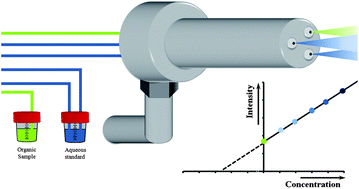A new multinebulizer, based on Flow Blurring® technology (FBMN), is evaluated for a simple, fast and direct analysis of organic samples in Inductively Coupled Plasma Optical Emission Spectrometry (ICP OES). Organic samples are analyzed by on-line standard addition calibration using aqueous calibration standards. A Standard Sample Introduction (SSI) system (i.e., MicroMist® commercial nebulizer (MM) and a spray chamber) is used for comparison using a conventional standard addition with organic calibration standards. Both systems are coupled to the same cyclonic-type spray chamber and organic samples are nebulized at the same flow rate (100 μL min−1). Aerosol characterization revealed that when using the FBMN, practically all the organic primary aerosol volume is contained in droplets smaller than 33 μm, whereas when using the MM nebulizer, it is contained in droplets smaller than 114 μm. The on-line standard addition calibration was tested with diluted oil samples, providing results as accurate as those obtained with the reference system, with percent relative error values ranging from −5% to 4% for the reference system, and slightly lower, from −3% to 3% for the FBMN-based system. Figures of merit estimation shows that sensitivity, precision and limits of detection are better in the on-line calibration analysis than in the conventional one. In particular, long-term stability studies reveal that the addition of water in the on-line standard addition calibration significantly contributes to carbon compounds combustion, and therefore eliminates spectral interferences from carbon compounds and avoids carbon deposits in ICP components. After 2 hours of continuous organic sample introduction, the RSD (%) values ranged between 1.5% and 2% with the FBMN-based system and between 10% and 13% with the SSI system. Accuracy and uncertainty of the proposed on-line calibration was also evaluated in the analysis of various organic samples (i.e., biodiesel certified material and real diesel samples). In the analysis of certified reference material, the relative error values were found to be in the range from −4% to +4% for the SSI system and from −4% to +1.0% for the FBMN-based system. Recovery values of real samples of 5% biodiesel in diesel were, in all cases, close to 100%.


 Please wait while we load your content...
Please wait while we load your content...